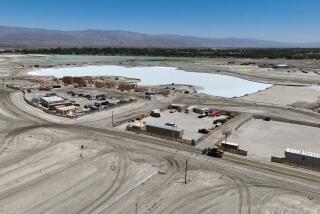Is What’s Good for Disney Good for Anaheim? : Development: Debate centers on whether government should provide $800-million subsidy to the entertainment firm to enhance resort area.
- Share via
ANAHEIM — Eight-hundred-million dollars is enough money to staff an entire police department, shelter thousands of homeless or build dozens of schools. So why should the city, state and federal governments invest that spectacular sum to help the Walt Disney Co. build a resort in Anaheim?
Disney and the city say that the project would create thousands of jobs and a stream of tax revenue. But spending such vast amounts of taxpayer dollars to support one of America’s richest corporations is as incongruous to some as the thought of Mickey Mouse standing in a welfare line.
“I find it hard to believe there is a compelling argument for a public subsidy,” said Peter Eisinger, director of the LaFollette Institute of Public Affairs at the University of Wisconsin. Disney “is a proven moneymaker. . . . Why should the city be spending its scarce resources to create minimum-wage jobs?”
Others see the project as a way to get the Southland economy moving again, even if the public has to foot part of the bill. “Without Disneyland, Southern California wouldn’t be as good as it is today, and therefore the government should help support Disney’s effort to build the project,” said Irvine architect David Baab.
Billed as one of the largest private construction efforts ever undertaken in Southern California, Disney’s $3-billion resort would include an internationally themed amusement park, three new hotels, restaurants, two of the world’s largest parking structures, extensive landscaping and a man-made lake.
But none of it will be built, Disney officials have warned, unless the city, state and federal governments chip in as much as $800 million for parking structures, freeway off-ramps, sewers, utility line relocation and other public works.
“The fact that we happen to be a successful company I’m sure causes questions to be raised,” said Ken Wong, a senior vice president of the Disney Development Co. “But if I were a (government) decision maker, I would want to invest in . . . public infrastructure that would stimulate companies that I know would deliver.”
Disney Chairman Michael Eisner said that because California’s business climate has turned chilly and building costs are exceedingly high, the project will not be feasible unless government shares part of the cost.
The request is being treated seriously by government officials. Gov. Pete Wilson has promised $60 million in transportation funds in direct support of the project, despite the state’s troubled fiscal condition that has required cuts in social services and higher education. Last week, U.S. House and Senate conferees approved $15.5 million toward the $223-million cost of one of the project’s two huge parking structures, which will double as a transit bus terminal.
In the next major step, Anaheim is negotiating with Disney over its share of public works costs. Both sides are expected to resolve their conflicts and announce a deal by early next year.
Now that the city has decided it is willing to make concessions, it is asking itself how far it should go to accommodate a Wall Street darling that had profits of $816.7 million last year--roughly equal to the amount it is demanding of government.
Trying to evaluate whether taxpayers should contribute to funding the project--and if so, how much--requires a look at what each side has to gain, and how badly each needs the project.
Disney needs it to add some new life to its aging flagship, Disneyland. The project would allow the company to emulate its Florida success formula: Build an adjacent resort of multiple theme parks and hotels that keep visitors spending “Disney dollars” day and night.
Disneyland’s 12 million visitors a year fuel Anaheim’s $4.7-billion tourist economy, and an expansion, proponents argue, would spur badly needed improvements to the area around the park, which has deteriorated in the 38 years since it opened.
Also, the project has engendered considerable public and business support because of the level of economic benefits Disney promises: an estimated 28,000 jobs, inside and outside the resort, with park visitors and employees pumping another $2.3 billion a year into the moribund Southland economy, according to a study commissioned by Disney. Much of that spending would stay with the restaurant, gift shop and hotel owners near Anaheim. The project would also create thousands of construction jobs.
Because of the depressed economy, Disney may stand a better chance of getting funding from the city of Anaheim, said urban affairs expert Christopher B. Leinberger, managing partner of Robert Charles Lesser & Co., a Los Angeles-based real estate advisory firm. “If Anaheim is hungrier because it is looking for new economic stimulus and new jobs, it will cut (Disney) a better deal than if this were 1988, when there was not a cloud on the horizon.”
Certainly, the notion of public funds being committed to private projects is not new. From the federal government guarantees on nearly $1 billion in loans to Chrysler Corp. in 1980 to local governments’ generous tax relief and other inducements for numerous auto malls throughout Southern California, government has steadily increased its investment in the private sector.
Wisconsin’s Eisinger notes that South Carolina shelled out about $68,000 per job to lure Germany’s BMW to open an auto plant in its state. Fuji Isuzu received about $50,000 a job in government monies to build a car factory in Lafayette, Ind., and Diamond-Star Motors, a subsidiary of Mitsubishi Motors Corp., got about $40,000 per job in incentives for a Mitsubishi auto plant in Bloomington, Ind.
This month, Alabama upped the ante when it gave Mercedes-Benz incentives amounting to as much as $200,000 a job to build a plant outside Tuscaloosa.
Those, however, are high-paying, largely skilled manufacturing jobs. By contrast, the Disneyland Resort would be staffed largely as the Magic Kingdom is now, by college students and others working part time in entry-level jobs that pay close to minimum wage.
Using Eisinger’s methodology, Disney is asking for a government subsidy that amounts to about $28,500 for each of the permanent jobs created; $64,000 each if applied to just those jobs created inside the project.
With such an extensive public cost, the proposed Disney deal deserves a careful examination, said Cal State Fullerton professor Ray Young. “One has to stop and carefully examine (when) a corporation with such deep pockets is going to Washington or Sacramento or the city of Anaheim and asking for such high levels of support.”
Yet, Young said the project could yield long-term benefits for not just Anaheim, but all of Orange County. It comes at a time when the local tourist economy needs a boost, particularly given investment in other vacation destinations, he said.
Las Vegas, attempting to attract more family business, has witnessed a building boom as several mega-resorts have recently opened. And entertainment giant MCA--parent of the Universal Studios--last month announced a multibillion-dollar expansion of its theme park in Orlando, Fla.
Intent on keeping their city competitive, Anaheim officials are pursuing the Disneyland Resort as a priority. The city’s chief negotiator, Deputy City Manager Tom Wood, declines to comment specifically on the negotiations because of their crucial status, but maintains that the city will not enter into any deal that does not put the taxpayers ahead.
The city is predicting that the new theme park complex could deliver at least $27 million a year in additional tax revenue if it opens as projected in 1999.
“You have to be extremely cautious that there is no risk, a clear public purpose and substantial public benefit,” Wood said.
Disney’s Wong said the project could allow the city and Disney to get the “best bang for our buck.” But in no case, he said, will Disneyland be allowed to languish, even if the surrounding resort is never built.
“Disneyland is where it all started, and we will never let the polish go off that jewel,” Wong said. “We will always reinvest in Disneyland.”
More to Read
Inside the business of entertainment
The Wide Shot brings you news, analysis and insights on everything from streaming wars to production — and what it all means for the future.
You may occasionally receive promotional content from the Los Angeles Times.










